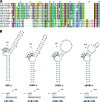The first full-length endogenous hepadnaviruses: identification and analysis
- PMID: 22718817
- PMCID: PMC3416111
- DOI: 10.1128/JVI.01164-12
The first full-length endogenous hepadnaviruses: identification and analysis
Abstract
In silico screening of metazoan genome data identified multiple endogenous hepadnaviral elements in the budgerigar (Melopsittacus undulatus) genome, most notably two elements comprising about 1.3 × and 1.0 × the full-length genome. Phylogenetic and molecular dating analyses show that endogenous budgerigar hepatitis B viruses (eBHBV) share an ancestor with extant avihepadnaviruses and infiltrated the budgerigar genome millions of years ago. Identification of full-length genomes with preserved key features like ε signals could enable resurrection of ancient BHBV.
Figures


References
-
- Emerman M, Malik HS. 2010. Paleovirology—modern consequences of ancient viruses. PLoS Biol. 8:e1000301 doi:10.1371/journal.pbio.1000301 - DOI - PMC - PubMed
Publication types
MeSH terms
Substances
Associated data
- GDB/JQ978774
- Actions
- Actions
- Actions
- Actions
- Actions
- Actions
- Actions
- Actions
- Actions
- Actions
- Actions
- Actions
LinkOut - more resources
Full Text Sources

